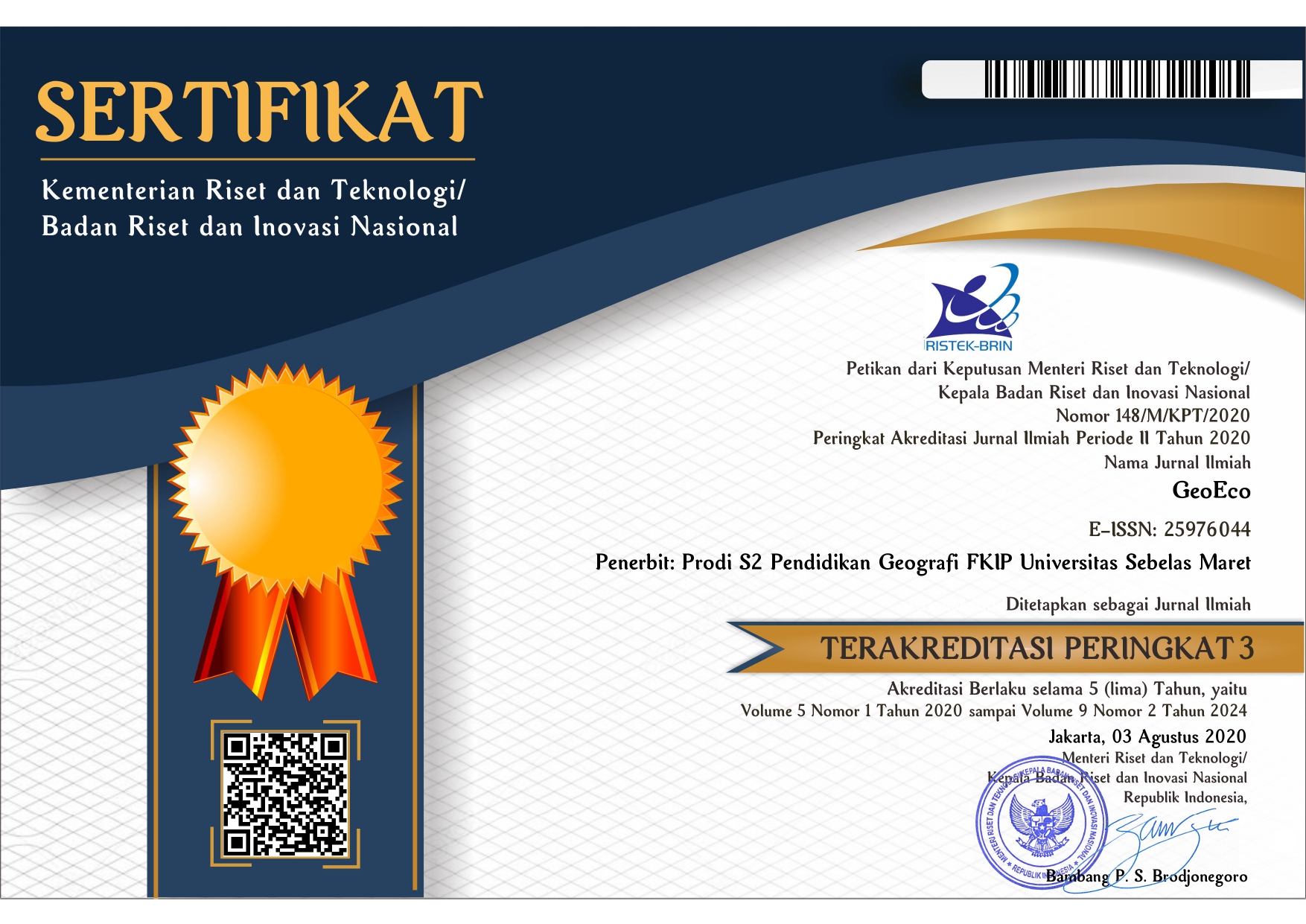ADAPTIVE CAPACITY AND RESILIENCE TO THE EARTHQUAKE AMONG STUDENTS IN KLATEN REGENCY
Abstract
One of the risk components that are most vulnerable to earthquake disasters is children. Klaten Regency is one of the areas frequently shaken by earthquakes. Therefore, this study aims to measure students' adaptive capacity and resilience to earthquakes in the Klaten Regency. Respondents in this study were students of SMP M 8 Wedi, MTs M 10 Wedi, and SMP M 21gantiwarno, Klaten Regency. The adaptive capacity of students is measured based on institutional memory, innovative learning, and connectedness. In contrast, students' resilience level is measured based on emotion regulation, control over problems, optimism, empathy, self-efficacy, ability to analyze issues, and achievement. Data were collected using a questionnaire and processed using descriptive statistics. The level of adaptive capacity and resilience of the student community to natural disasters has different characteristics due to the influence of several factors such as the location of the school in a disaster-prone area, the integration of disaster material into learning, experience in disaster emergency response conditions, school policies on disaster mitigation and family or community factors environment. The best level of adaptive capacity is found in SMP Muhammadiyah 8 Wedi with 62.90%, and MTs Muhammadiyah 10 Wedi has a poor level of adaptive capacity with 44.32%. Moreover, based on gender characteristics, the level of adaptive capacity of male students is better than female students, with the lowest percentage being female at MTs Muhammadiyah 10 Wedi. The highest level of student resilience is found at MTs Muhammadiyah 10 Wedi at 61.36%, while SMP Muhammadiyah 21 Gantiwarno is classified as poor at 33.33%. Based on gender characteristics, the highest level of resilience is female at MTs Muhammadiyah 10 Wedi, with 91.67%.
Keywords
Full Text:
PDFReferences
Ahmed, S., Fajber, E., Ahmed, S., & Fajber, E. (2009). Engendering adaptation to climate variability in Gujarat , India Engendering adaptation to climate variability in Gujarat , India. August 2014, 37–41. https://doi.org/10.1080/13552070802696896
Badan Nasional Pennggulangan Bencana. (2013). Indeks Rawan Bencana Indonesia. Badan Nasional Penanggulangan Bencana (BNPB).
Blanchard-boehm, R. D., Cook, M. J., Blanchard-boehm, R. D., & Cook, M. J. (2009). Risk Communication and Public Education in Edmonton , Alberta , Canada on the 10th Anniversary of the ‘ Black Friday ’ Tornado. International Research in Geographical and Environmental Education, December 2014, 37–41. https://doi.org/10.1080/10382040408668791
Bouillet, D., Ivanec, T. P., & Inclusion, A. E. (2014). Preschool teachers ’ resilience and their readiness for building children ’ s resilience. Health Education, 114 (6)(September), 435–450. https://doi.org/10.1108/HE-11-2013-0062
Castillo, E. A., Trinh, M. P., Castillo, E. A., & Trinh, M. P. (2018). Catalyzing capacity : absorptive , adaptive , and generative leadership. https://doi.org/10.1108/JOCM-04-2017-0100
Choudhury, M. U. I., & Haque, C. E. (2016). “We are more scared of the power elites than the floods”: Adaptive capacity and resilience of wetland community to flash flood disasters in Bangladesh. International Journal of Disaster Risk Reduction, 19, 145–158. https://doi.org/10.1016/j.ijdrr.2016.08.004
Davoudi, S., Shaw, K., Haider, L. J., Quinlan, A. E., Peterson, G. D., Wilkinson, C., Fünfgeld, H., & Mcevoy, D. (2012). Resilience : A Bridging Concept or a Dead End ? “ Reframing ” Resilience : Challenges for Planning Theory and Practice Interacting Traps : Resilience Assessment of a Pasture Management System in Northern Afghanistan Urban Resilience : What Does it Mean in Planning Practice ? Resilience as a Useful Concept for Climate Change Adaptation ? The Politics of Resilience for Planning : A Cautionary Note. May 2013, 299–333.
Der Sarkissian, R., Zaninetti, J. M., & Abdallah, C. (2019). The use of geospatial information as support for Disaster Risk Reduction; contextualization to Baalbek-Hermel Governorate/Lebanon. Applied Geography, 111(August), 102075. https://doi.org/10.1016/j.apgeog.2019.102075
Djalante, R., & Lassa, S. (2019). Governing complexities and its implication on the Sendai Framework for Disaster Risk Reduction priority 2 on governance. Progress in Disaster Science, 2, 100010. https://doi.org/10.1016/j.pdisas.2019.100010
Djunaedi, A., Probosubanu, L., & Mada, U. G. (2011). Peraturan Zonasi : Peran Dalam Pemanfaatan Ruang dan Pembangunan Kembali di Kawasan Rawan Bencana Kasus : Arkadelphia City , Arkansas USA. Forum Teknik, 34(26), 17–26.
Dwiningrum, S. I. A., Prihastuti, & Suwarjo. (2017). SOCIAL CAPITAL AND SCHOOL RESILIENCE FOR DISASTER MITIGATION EDUCATION IN YOGYAKARTA SCHOOLS. Jurnal Kependidikan, 1(1), 84–99.
Elnashai, A. S., Kim, S. J., Yun, G. J., & Sidarta, D. (2006). The Yogyakarta Earthquake of May 27. Headquarters: University of Illinois at Urbana-Champaign.
Etinay, N., Egbu, C., & Murray, V. (2018). Building Urban Resilience for Disaster Risk Management and Disaster Risk Reduction. Procedia Engineering, 212(2017), 575–582. https://doi.org/10.1016/j.proeng.2018.01.074
Ferro-Azcona, H., Espinoza-Tenorio, A., Calderón-Contreras, R., Ramenzoni, V. C., Gómez País, M. de las M., & Mesa-Jurado, M. A. (2019). Adaptive capacity and social-ecological resilience of coastal areas: A systematic review. Ocean and Coastal Management, 173(January), 36–51. https://doi.org/10.1016/j.ocecoaman.2019.01.005
Fischer, A. P., Frazier, T. G., Paige, A., Frazier, T. G., Vulnerability, S., Fischer, A. P., & Frazier, T. G. (2017). Social Vulnerability to Climate Change in Temperate Forest Areas : New Measures of Exposure , Sensitivity , and Adaptive Capacity Social Vulnerability to Climate Change in Temperate Forest Areas : New Measures of Exposure , Sensitivity , and Adaptive Capacity. 4452(December). https://doi.org/10.1080/24694452.2017.1387046
Husein, S. (2016). Bencana Gempabumi. https://doi.org/10.13140/RG.2.1.1112.6808
Justice, J., Wall, E., & Marzall, K. (2007). Local Environment : The International Adaptive capacity for climate change in Canadian rural communities Adaptive Capacity for Climate Change in Canadian Rural Communities. October 2014, 37–41. https://doi.org/10.1080/13549830600785506
Kim, H., Woosnam, K. M., Marcouiller, D. W., Kim, H., Kim, H., Woosnam, K. M., & Marcouiller, D. W. (2021). Seeking anticipatory adaptation : adaptive capacity and resilience to flood risk. Environmental Hazards, 0(0), 1–22. https://doi.org/10.1080/17477891.2021.1902783
Labaria, E. C., Acosta, A., & Gotangco, harlotte K. (2020). CHAPTER 4 MINDING MENTAL HEALTH IN DISASTER RISK REDUCTION AND MANAGEMENT : ENHANCING RESISTANCE THROUGH DISASTER PREVENTION , MITIGATION , AND PREPAREDNESS Elirozz Carlie Labaria , Avegale Acosta and. Resistance, Resilience, and Recovery from Disasters: Perspectives from Southeast Asia Community, Environment and Disaster Risk Management, 21, 53–71. https://doi.org/10.1108/S2040-726220200000021004
Lohmann, H. (2016). Comparing vulnerability and adaptive capacity to climate change in individuals of coastal Dominican Republic. Ocean and Coastal Management, 132, 111–119. https://doi.org/10.1016/j.ocecoaman.2016.08.009
Manyena, B., Machingura, F., & O’Keefe, P. (2019). Disaster Resilience Integrated Framework for Transformation (DRIFT): A new approach to theorising and operationalising resilience. World Development, 123, 104587. https://doi.org/10.1016/j.worlddev.2019.06.011
Marfai, M. A., Sunarto, Khakim, N., Fatchurohman, H., Cahyadi, A., Wibowo, Y. A., & Rosaji, F. S. C. (2019). Tsunami hazard mapping and loss estimation using geographic information system in Drini Beach, Gunungkidul Coastal Area, Yogyakarta, Indonesia. E3S Web of Conferences, 76. https://doi.org/10.1051/e3sconf/20197603010
Meerow, S., Newell, J. P., & Newell, J. P. (2016). Urban resilience for whom , what , when , where , and why ? Urban resilience for whom , what , when , where , and why ? 3638(July). https://doi.org/10.1080/02723638.2016.1206395
Meerow, S., Pajouhesh, P., Miller, T. R., Meerow, S., & Miller, T. R. (2019). Social equity in urban resilience planning Social equity in urban resilience planning. Local Environment, 0(0), 1–16. https://doi.org/10.1080/13549839.2019.1645103
Munene, M. B., Swartling, Å. G., & Thomalla, F. (2018). Adaptive governance as a catalyst for transforming the relationship between development and disaster risk through the Sendai Framework? International Journal of Disaster Risk Reduction, 28(January), 653–663. https://doi.org/10.1016/j.ijdrr.2018.01.021
Musiyam, M. (2020). Analysis of Flood-Affected Areas Due to Extreme Weather In Pacitan, Indonesia. International Journal of GEOMATE, 19. https://doi.org/10.21660/2020.75.25688
Nguyen, K. A., Liou, Y. A., & Terry, J. P. (2019). Vulnerability of Vietnam to typhoons: A spatial assessment based on hazards, exposure and adaptive capacity. Science of the Total Environment, 682, 31–46. https://doi.org/10.1016/j.scitotenv.2019.04.069
Nur, A. M. (2010). Gempa Bumi, Tsunami Dan Mitigasinya. Gempa Bumi, Tsunami Dan Mitigasinya, 7(1). https://doi.org/10.15294/jg.v7i1.92
Paloviita, A., Kortetmäki, T., Puupponen, A., & Silvasti, T. (2017). Insights into food system exposure, coping capacity and adaptive capacity. British Food Journal, 119(12), 2851–2862. https://doi.org/10.1108/BFJ-02-2017-0057
Rufat, S., Tate, E., Emrich, C. T., Antolini, F., Rufat, S., Tate, E., Emrich, C. T., Antolini, F., Rufat, S., Tate, E., Emrich, C. T., & Antolini, F. (2019). How Valid Are Social Vulnerability Models ? Annals of the American Association of Geographers, 0(0), 1–23. https://doi.org/10.1080/24694452.2018.1535887
Stock, R., Birkenholtz, T., & Garg, A. (2017). Let the people speak : improving regional adaptation policy by combining adaptive capacity assessments with vulnerability perceptions of farmers in Gujarat , India. Climate and Development, 0(0), 1–15. https://doi.org/10.1080/17565529.2017.1410089
Syahputri, D. M., Wibowo, Y. A., Nur Hafida, S. H., Widiyatmoko, W., Anwar, Y., & Dewi, R. P. (2022). Implementation of comprehensive school safety: the risk reduction and resilience education pillar in State Senior High School 1 of Pacitan and Islamic State Senior High School 1 of Pacitan, Indonesia. IOP Conference Series: Earth and Environmental Science, 986(1). https://doi.org/10.1088/1755-1315/986/1/012016
Tate, E. (2013). Annals of the Association of American Geographers. July, 37–41. https://doi.org/10.1080/00045608.2012.700616
Walker, S. E., Bruyere, B. L., Zarestky, J., Yasin, A., Lolemu, A., Pickering, T., Walker, S. E., Bruyere, B. L., Zarestky, J., Yasin, A., Walker, S. E., Pickering, T., & Zarestky, J. (2021). Education and adaptive capacity : the influence of formal education on climate change adaptation of pastoral women change adaptation of pastoral women. Climate and Development, 0(0), 1–10. https://doi.org/10.1080/17565529.2021.1930508
Wibowo, Y. A., Marfai, M. A., Hadi, M. P., Fatchurohman, H., Ronggowulan, L., & Arif, D. A. (2022). Geospatial technology for flood hazard analysis in Comal Watershed, Central Java, Indonesia. IOP Conference Series: Earth and Environmental Science, 1039(1), 012027. https://doi.org/10.1088/1755-1315/1039/1/012027
Refbacks
- There are currently no refbacks.












.png)

